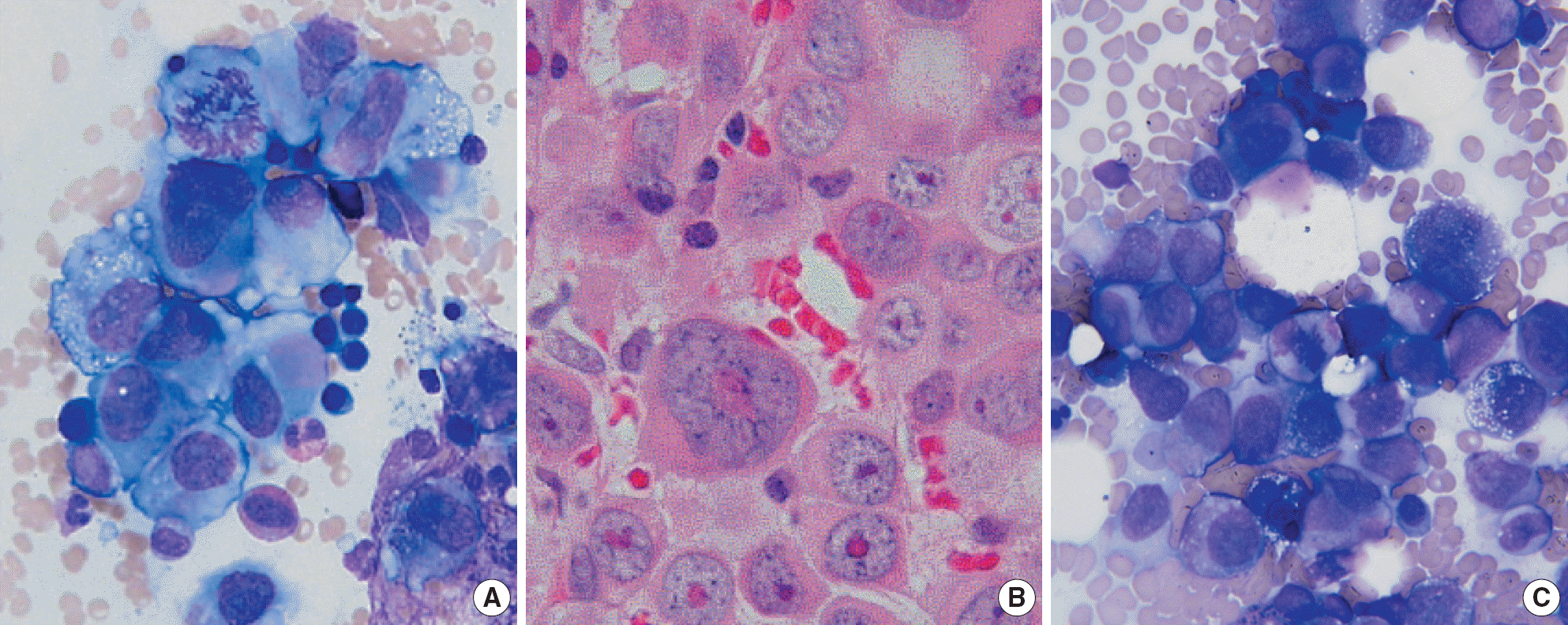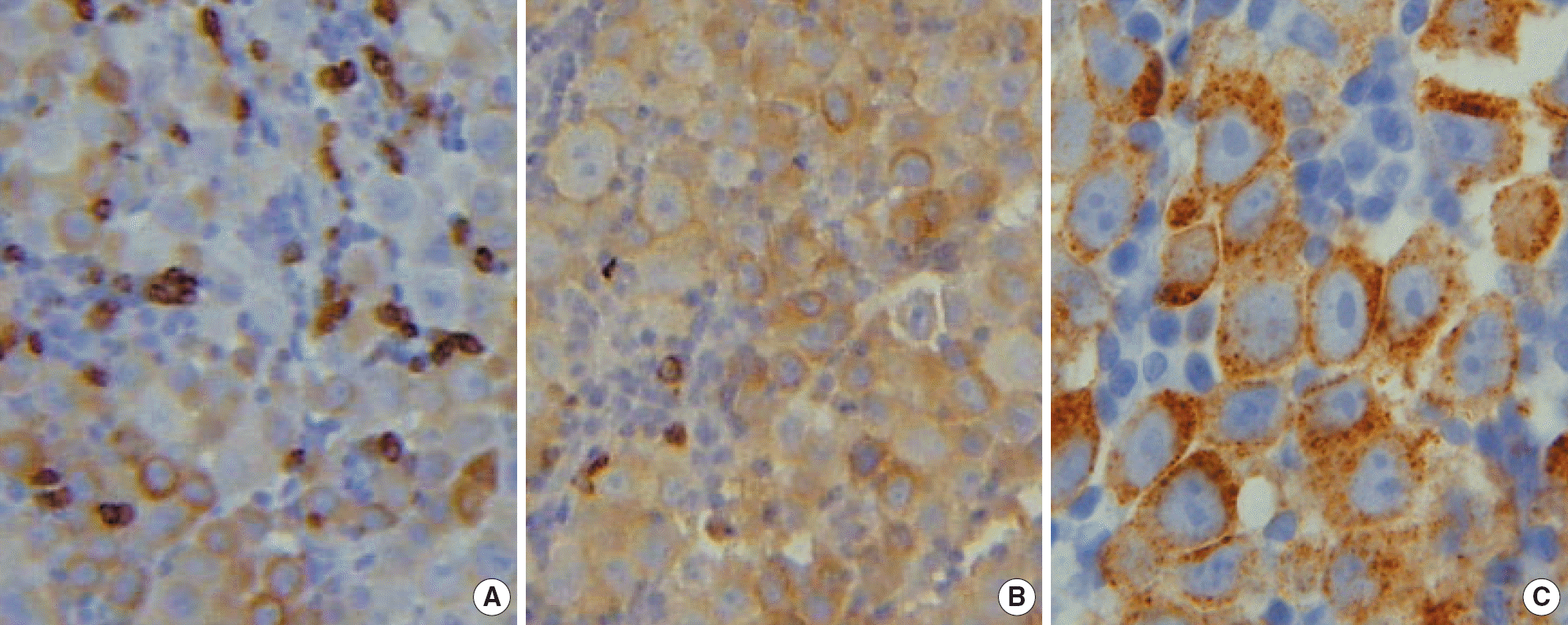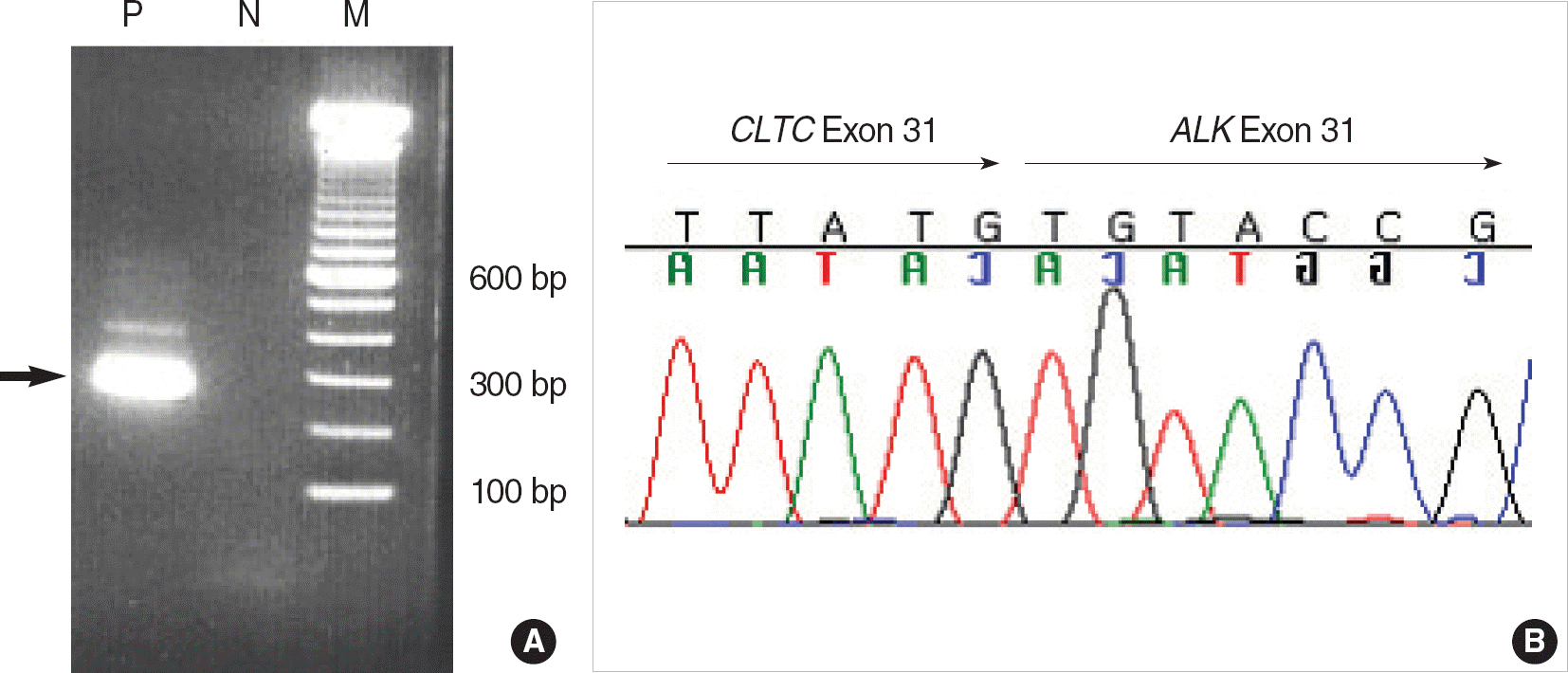Abstract
Aanaplastic lymphoma kinase (ALK)-positive diffuse large B-cell lymphoma (DLBCL) is an unusual disease entity first reported in 1997 as DLBCL with expression of full-length ALK protein. The World Health Organization classification enlists the disease as a rare variant of DLBCL. Herein we describe two cases of ALK-positive DLBCL with cytomorphologic and molecular characteristics for the first time in Korea. The patients were 35-yr-old and 24-yr-old male patients. Immunohistochemical studies on the lymph nodes revealed large sized neoplastic cells with plasmablastic differentiation, which were negative for CD30 and positive for ALK with the characteristic granular staining in the cytoplasmic region. Extensive involvement of bone marrow was observed in both cases showing large, extremely atypical cells. Fluorescence in situ hybridization and molecular studies on the bone marrow aspirate specimens led to the detection of a clathrin (CLTC)/ALK rearrangement. Despite aggressive chemotherapy, the patients died 15 and 17 months after the diagnosis, indicating poor prognosis of the disease entity. This is the first report demonstrating the cytomorphologic findings of ALK-positive DLBCL cells on bone marrow aspirates.
REFERENCES
1.Jaffe ES, Harris NL, editors. WHO classification of tumours. Pathology and genetics of tumours of haematopoietic and lymphoid tissues. Lyon: IARC Press;2001.
2.Delsol G., Lamant L., Mariame B., Pulford K., Dastugue N., Brousset P, et al. A new subtype of large B-cell lymphoma expressing the ALK kinase and lacking the 2; 5 translocation. Blood. 1997. 89:1483–90.

3.Morris SW., Kirstein MN., Valentine MB., Dittmer KG., Shapiro DN., Saltman DL, et al. Fusion of a kinase gene, ALK, to a nucleolar protein gene, NPM, in non-Hodgkin's lymphoma. Science. 1994. 263:1281–4.
4.Dirks WG., Fahnrich S., Lis Y., Becker E., MacLeod RA., Drexler HG. Expression and functional analysis of the anaplastic lymphoma kinase (ALK) gene in tumor cell lines. Int J Cancer. 2002. 100:49–56.

5.Lamant L., Pulford K., Bischof D., Morris SW., Mason DY., Delsol G, et al. Expression of the ALK tyrosine kinase gene in neuroblastoma. Am J Pathol. 2000. 156:1711–21.

6.Adam P., Katzenberger T., Seeberger H., Gattenlohner S., Wolf J., Steinlein C, et al. A case of a diffuse large B-cell lymphoma of plasmablastic type associated with the t(2;5)(p23;q35) chromosome translocation. Am J Surg Pathol. 2003. 27:1473–6.

7.Onciu M., Behm FG., Downing JR., Shurtleff SA., Raimondi SC., Ma Z, et al. ALK-positive plasmablastic B-cell lymphoma with expression of the NPM-ALK fusion transcript: report of 2 cases. Blood. 2003. 102:2642–4.

8.Bubala H., Maldyk J., Wlodarska I., Sonta-Jakimczyk D., Szczepanski T. ALK-positive diffuse large B-cell lymphoma. Pediatr Blood Cancer. 2006. 46:649–53.
9.Chikatsu N., Kojima H., Suzukawa K., Shinagawa A., Nagasawa T., Ozawa H, et al. ALK+, CD30-, CD20- large B-cell lymphoma containing anaplastic lymphoma kinase (ALK) fused to clathrin heavy chain gene (CLTC). Mod Pathol. 2003. 16:828–32.

10.De Paepe P., Baens M., van Krieken H., Verhasselt B., Stul M., Simons A, et al. ALK activation by the CLTC-ALK fusion is a recurrent event in large B-cell lymphoma. Blood. 2003. 102:2638–41.

11.Gascoyne RD., Lamant L., Martin-Subero JI., Lestou VS., Harris NL., Muller-Hermelink HK, et al. ALK-positive diffuse large B-cell lymphoma is associated with Clathrin-ALK rearrangements: report of 6 cases. Blood. 2003. 102:2568–73.

12.Gesk S., Gascoyne RD., Schnitzer B., Bakshi N., Janssen D., Klapper W, et al. ALK-positive diffuse large B-cell lymphoma with ALK-Clathrin fusion belongs to the spectrum of pediatric lymphomas. Leukemia. 2005. 19:1839–40.

13.McManus DT., Catherwood MA., Carey PD., Cuthbert RJ., Alexander HD. ALK-positive diffuse large B-cell lymphoma of the stomach associated with a clathrin-ALK rearrangement. Hum Pathol. 2004. 35:1285–8.

14.Touriol C., Greenland C., Lamant L., Pulford K., Bernard F., Rousset T, et al. Further demonstration of the diversity of chromosomal changes involving 2p23 in ALK-positive lymphoma: 2 cases expressing ALK kinase fused to CLTCL (clathrin chain polypeptide-like). Blood. 2000. 95:3204–7.

15.Pulford K., Morris SW., Turturro F. Anaplastic lymphoma kinase proteins in growth control and cancer. J Cell Physiol. 2004. 199:330–58.

16.Falini B., Bigerna B., Fizzotti M., Pulford K., Pileri SA., Delsol G, et al. ALK expression defines a distinct group of T/null lymphomas (ALK lymphomas“) with a wide morphological spectrum. Am J Pathol. 1998. 153:875–86.

17.Falini B., Mason DY. Proteins encoded by genes involved in chromosomal alterations in lymphoma and leukemia: clinical value of their detection by immunocytochemistry. Blood. 2002. 99:409–26.

Fig. 1.
(A) Bone marrow aspirate smear in Case 1 showing neoplastic cells with extremely large size and bizarre morphology (Wright-Giemsa stain, ×1,000). (B) Bone marrow biopsy section in Case 1 showed that the bone marrow was packed with the large neoplastic cells (H&E stain, ×1,000). (C) Bone marrow aspirate smear in Case 2 showing neoplastic cells with irregular morphology smaller than those in Case 1, but still large (Wright-Giemsa stain, ×1,000).

Fig. 2.
Immunohistochemical stains on lymph node biopsy in Case 1. The large neoplastic cells showed positivity to CD79a (×200) (A), weak kappa restriction (×200) (B), and granular cytoplasmic positivity to ALK (×1,000) (C).

Fig. 3.
Fluorescence in situ hybridization (FISH) study for the ALK gene rearrangement (Dual-color Break-apart Probe, Vysis). (A) Interphase FISH and (B) metaphase FISH in Case 1. Note that the unusually large sized neoplastic cells had two fusion, two red, and one green signal indicating polyploidy with ALK gene rearrangement, while relatively small-sized normal bone marrow hematopoietic cells had two fusion signals. (C) Interphase FISH in Case 2. Large neo-plastic cells had one fusion and one red signal indicating 5′ deletion of ALK gene.





 PDF
PDF ePub
ePub Citation
Citation Print
Print



 XML Download
XML Download